Abstract
Single cell experiments in primates show that there are two major parallel pathways named after the lamination in the lateral geniculate nucleus. Each of these systems can be preferentially excited by appropriate stimuli. Here we report that in man the polarity of the evoked potentials both in retina and in cortex depends on which of these pathways is stimulated. The identification of the resulting waveforms is thereby simplified--a matter of practical importance. The fact that at retina and cortex there are characteristic potentials may reflect the different cell biology of the two pathways.
Full text
PDF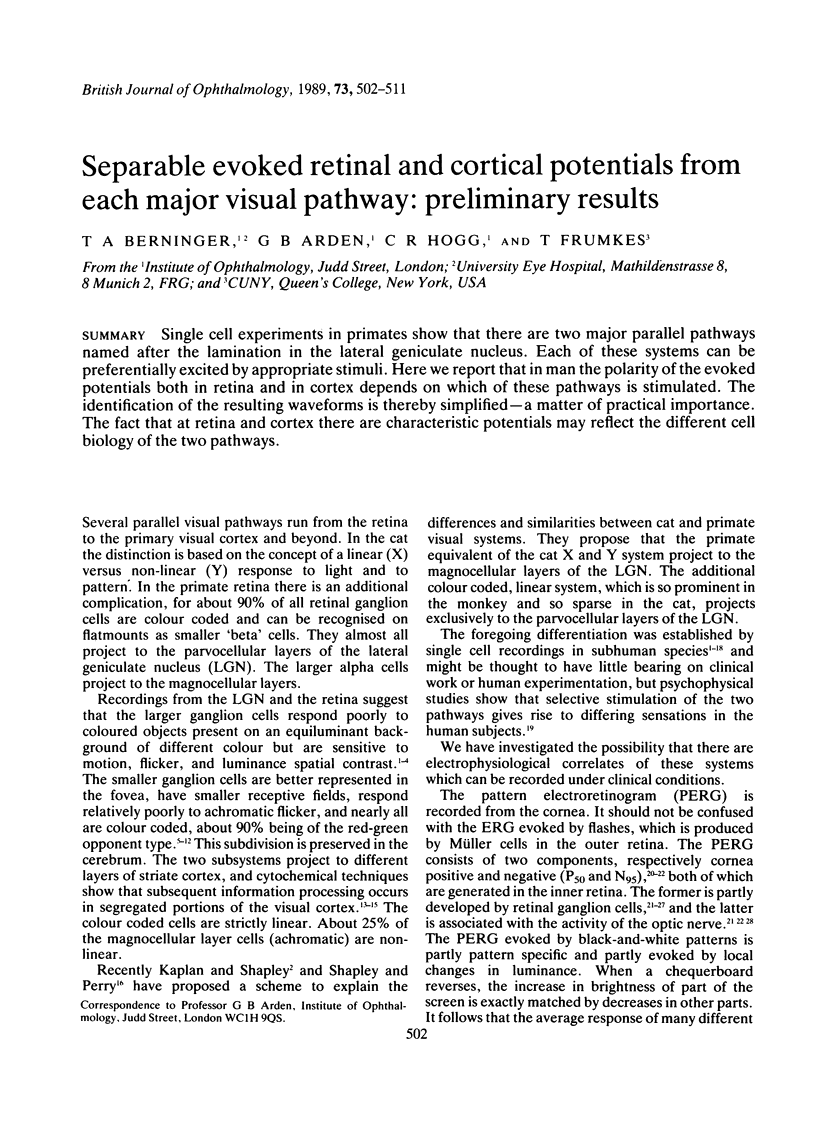
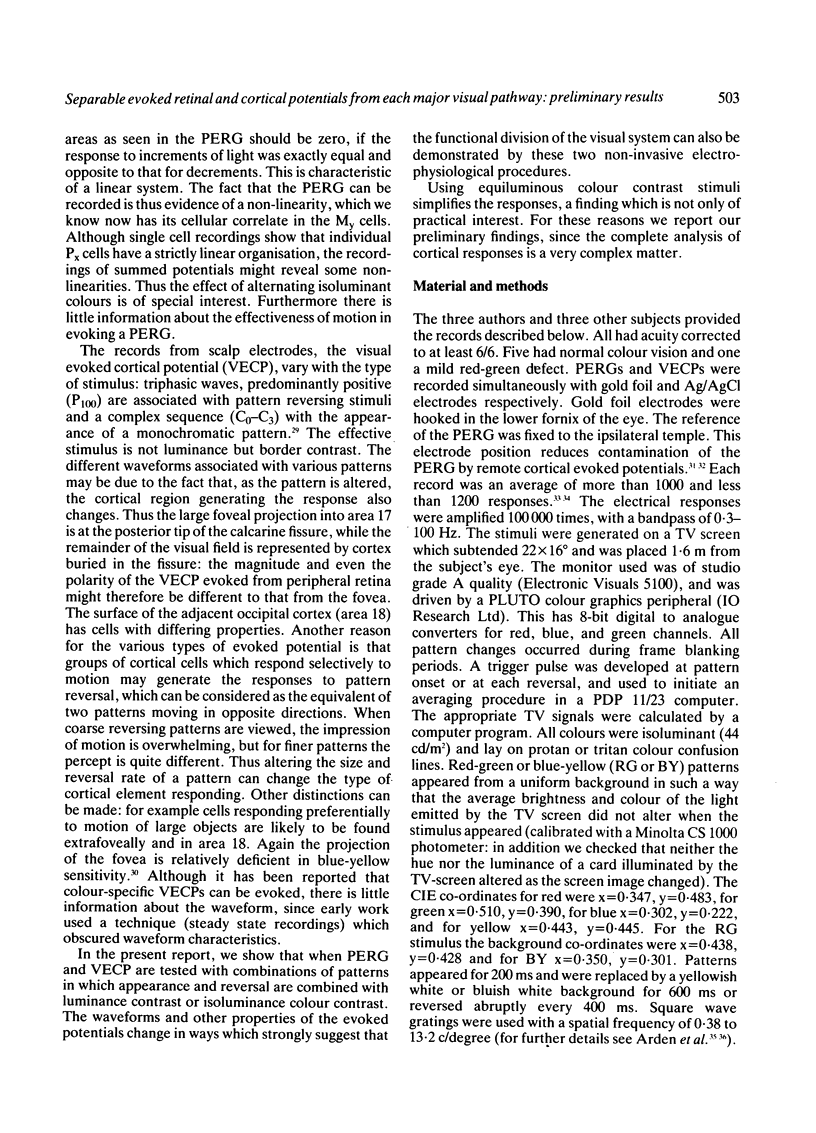
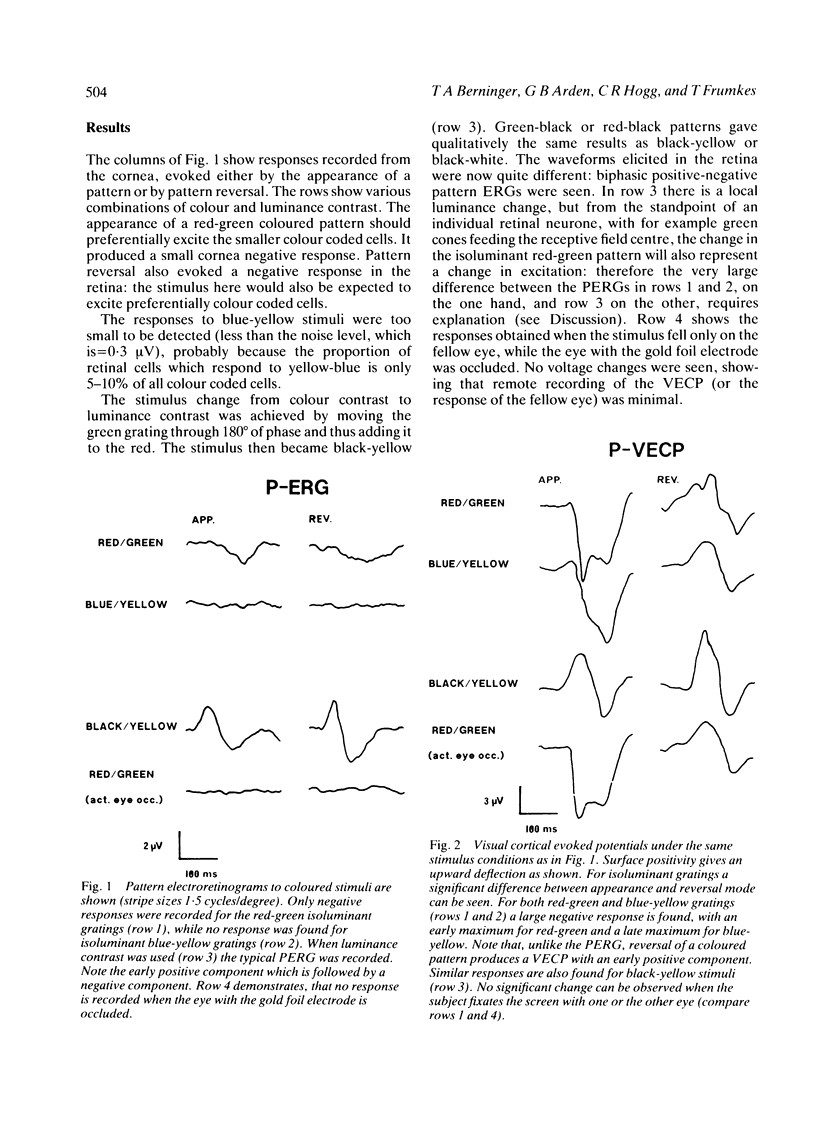
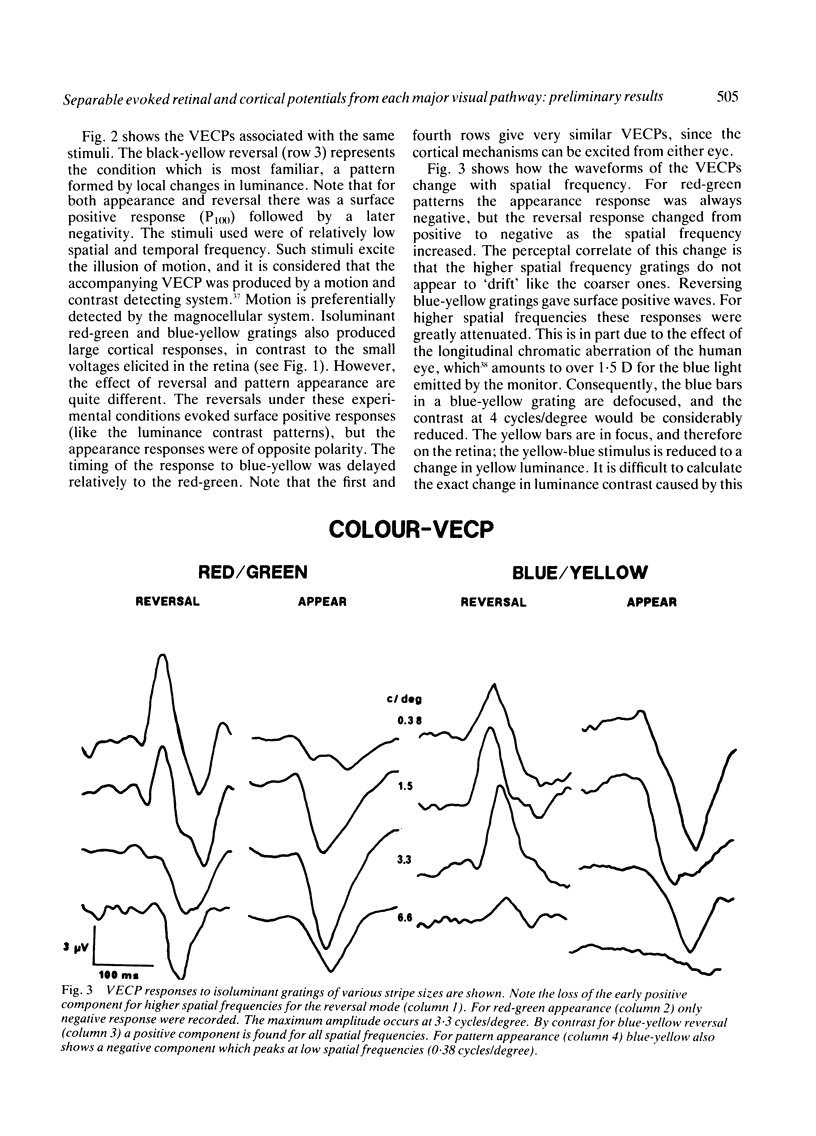
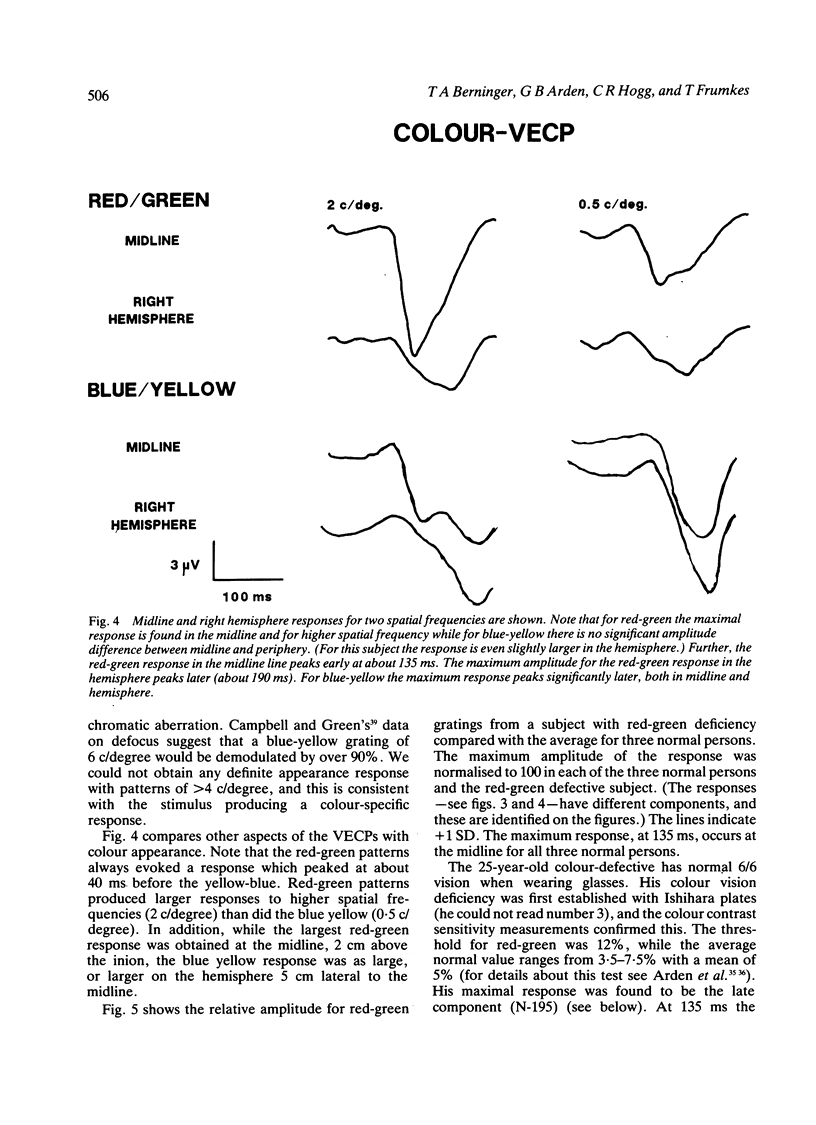


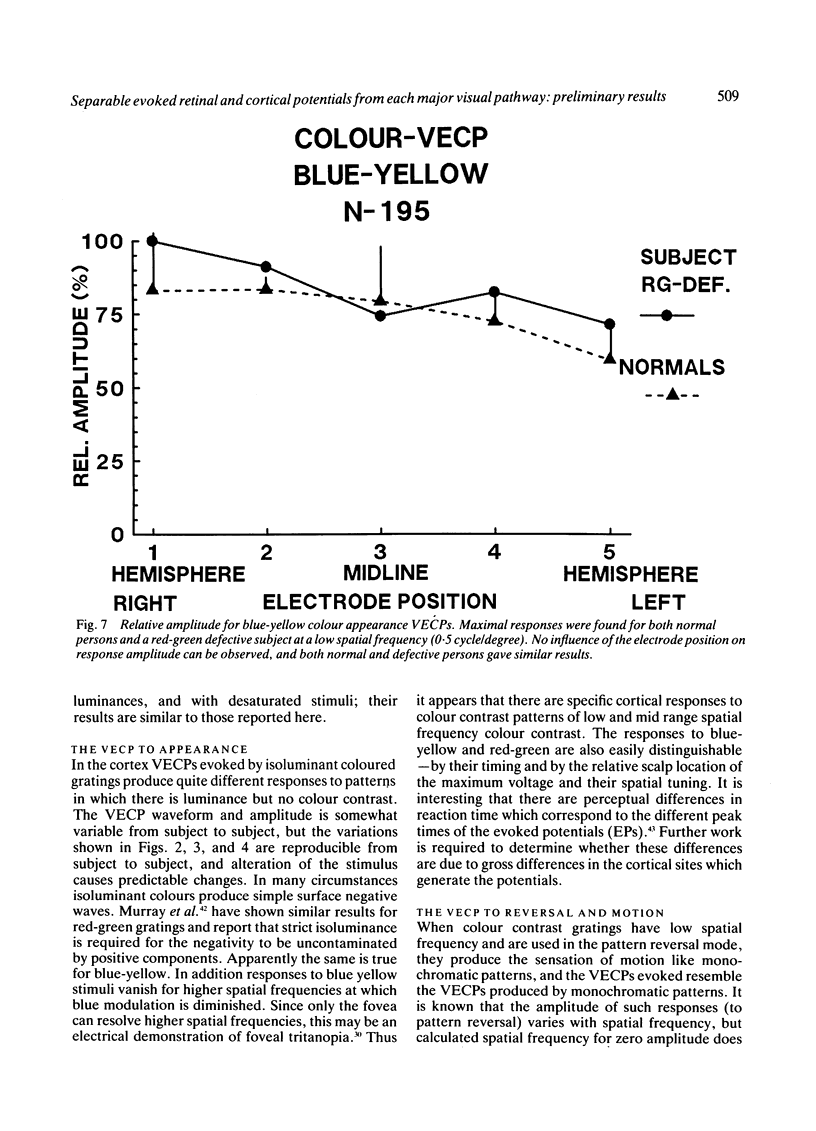
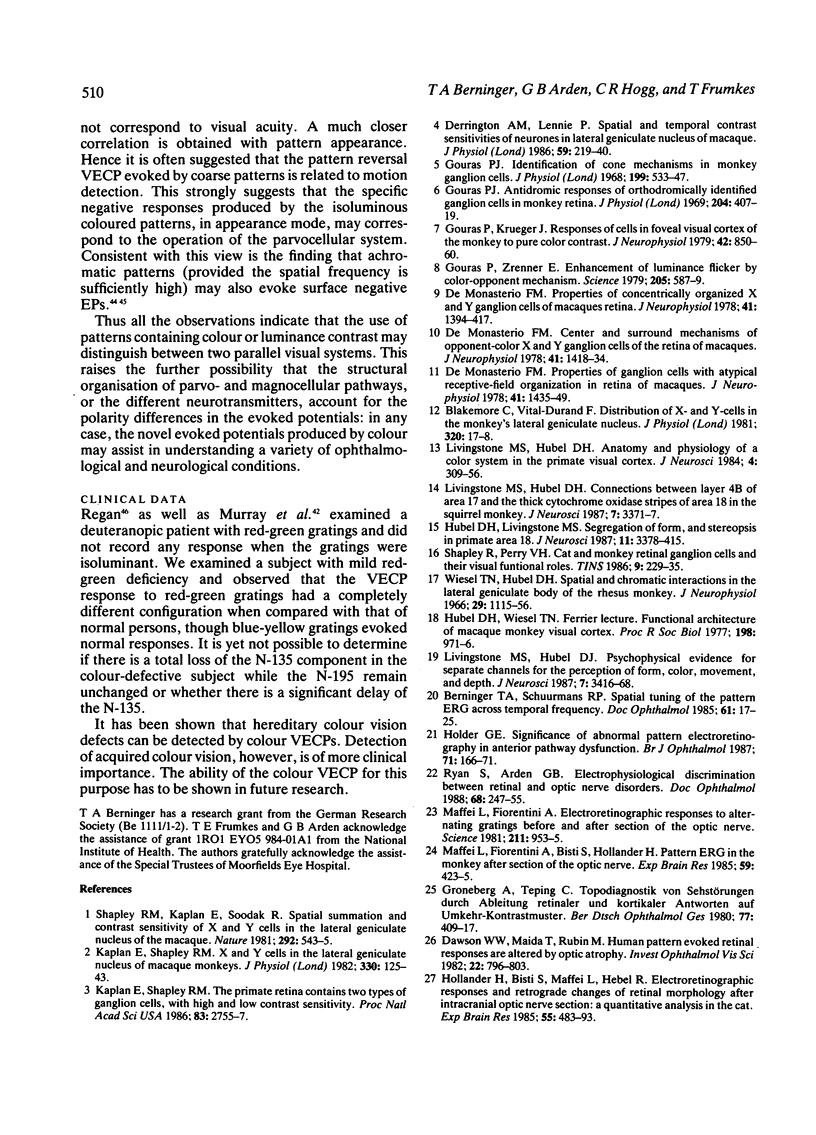
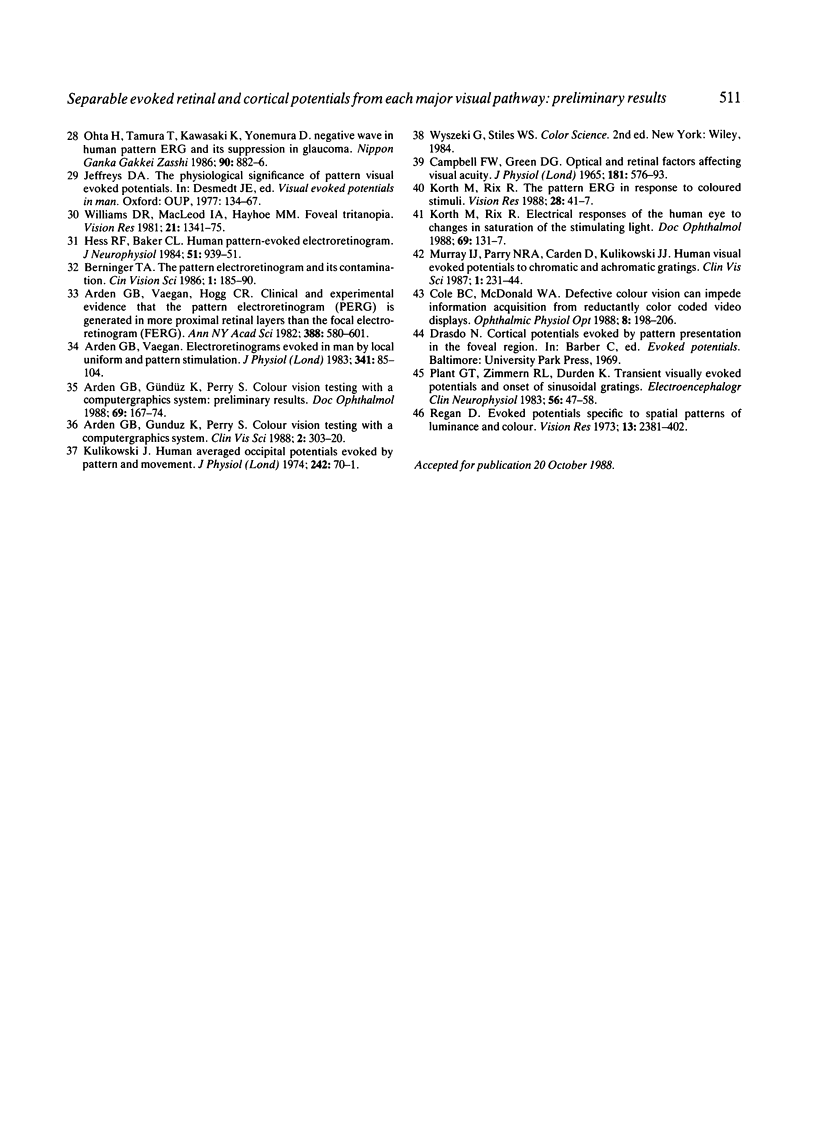
Selected References
These references are in PubMed. This may not be the complete list of references from this article.
- Arden G. B., Vaegan Electroretinograms evoked in man by local uniform or patterned stimulation. J Physiol. 1983 Aug;341:85–104. doi: 10.1113/jphysiol.1983.sp014794. [DOI] [PMC free article] [PubMed] [Google Scholar]
- Arden G. B., Vaegan, Hogg C. R. Clinical and experimental evidence that the pattern electroretinogram (PERG) is generated in more proximal retinal layers than the focal electroretinogram (FERG). Ann N Y Acad Sci. 1982;388:580–607. doi: 10.1111/j.1749-6632.1982.tb50818.x. [DOI] [PubMed] [Google Scholar]
- Arden G., Gündüz K., Perry S. Color vision testing with a computer graphics system: preliminary results. Doc Ophthalmol. 1988 Jun;69(2):167–174. doi: 10.1007/BF00153698. [DOI] [PubMed] [Google Scholar]
- Berninger T., Schuurmans R. P. Spatial tuning of the pattern ERG across temporal frequency. Doc Ophthalmol. 1985 Oct 30;61(1):17–25. doi: 10.1007/BF00143211. [DOI] [PubMed] [Google Scholar]
- Campbell F. W., Green D. G. Optical and retinal factors affecting visual resolution. J Physiol. 1965 Dec;181(3):576–593. doi: 10.1113/jphysiol.1965.sp007784. [DOI] [PMC free article] [PubMed] [Google Scholar]
- Cole B. L., Macdonald W. A. Defective colour vision can impede information acquisition from redundantly colour-coded video displays. Ophthalmic Physiol Opt. 1988;8(2):198–210. doi: 10.1111/j.1475-1313.1988.tb01038.x. [DOI] [PubMed] [Google Scholar]
- Dawson W. W., Maida T. M., Rubin M. L. Human pattern-evoked retinal responses are altered by optic atrophy. Invest Ophthalmol Vis Sci. 1982 Jun;22(6):796–803. [PubMed] [Google Scholar]
- Gouras P. Antidromic responses of orthodromically identified ganglion cells in monkey retina. J Physiol. 1969 Oct;204(2):407–419. doi: 10.1113/jphysiol.1969.sp008920. [DOI] [PMC free article] [PubMed] [Google Scholar]
- Gouras P. Identification of cone mechanisms in monkey ganglion cells. J Physiol. 1968 Dec;199(3):533–547. doi: 10.1113/jphysiol.1968.sp008667. [DOI] [PMC free article] [PubMed] [Google Scholar]
- Gouras P., Krüger J. Responses of cells in foveal visual cortex of the monkey to pure color contrast. J Neurophysiol. 1979 May;42(3):850–860. doi: 10.1152/jn.1979.42.3.850. [DOI] [PubMed] [Google Scholar]
- Gouras P., Zrenner E. Enchancement of luminance flicker by color-opponent mechanisms. Science. 1979 Aug 10;205(4406):587–589. doi: 10.1126/science.109925. [DOI] [PubMed] [Google Scholar]
- Hess R. F., Baker C. L., Jr Human pattern-evoked electroretinogram. J Neurophysiol. 1984 May;51(5):939–951. doi: 10.1152/jn.1984.51.5.939. [DOI] [PubMed] [Google Scholar]
- Holder G. E. Significance of abnormal pattern electroretinography in anterior visual pathway dysfunction. Br J Ophthalmol. 1987 Mar;71(3):166–171. doi: 10.1136/bjo.71.3.166. [DOI] [PMC free article] [PubMed] [Google Scholar]
- Holländer H., Bisti S., Maffei L., Hebel R. Electroretinographic responses and retrograde changes of retinal morphology after intracranial optic nerve section. A quantitative analysis in the cat. Exp Brain Res. 1984;55(3):483–493. doi: 10.1007/BF00235279. [DOI] [PubMed] [Google Scholar]
- Hubel D. H., Livingstone M. S. Segregation of form, color, and stereopsis in primate area 18. J Neurosci. 1987 Nov;7(11):3378–3415. doi: 10.1523/JNEUROSCI.07-11-03378.1987. [DOI] [PMC free article] [PubMed] [Google Scholar]
- Kaplan E., Shapley R. M. The primate retina contains two types of ganglion cells, with high and low contrast sensitivity. Proc Natl Acad Sci U S A. 1986 Apr;83(8):2755–2757. doi: 10.1073/pnas.83.8.2755. [DOI] [PMC free article] [PubMed] [Google Scholar]
- Kaplan E., Shapley R. M. X and Y cells in the lateral geniculate nucleus of macaque monkeys. J Physiol. 1982 Sep;330:125–143. doi: 10.1113/jphysiol.1982.sp014333. [DOI] [PMC free article] [PubMed] [Google Scholar]
- Korth M., Rix R. Electrical responses of the human eye to changes in saturation of the stimulating light. Doc Ophthalmol. 1988 Jun;69(2):131–137. doi: 10.1007/BF00153693. [DOI] [PubMed] [Google Scholar]
- Korth M., Rix R. Luminance-contrast evoked responses and color-contrast evoked responses in the human electroretinogram. Vision Res. 1988;28(1):41–48. [PubMed] [Google Scholar]
- Livingstone M. S., Hubel D. H. Anatomy and physiology of a color system in the primate visual cortex. J Neurosci. 1984 Jan;4(1):309–356. doi: 10.1523/JNEUROSCI.04-01-00309.1984. [DOI] [PMC free article] [PubMed] [Google Scholar]
- Livingstone M. S., Hubel D. H. Connections between layer 4B of area 17 and the thick cytochrome oxidase stripes of area 18 in the squirrel monkey. J Neurosci. 1987 Nov;7(11):3371–3377. doi: 10.1523/JNEUROSCI.07-11-03371.1987. [DOI] [PMC free article] [PubMed] [Google Scholar]
- Livingstone M. S., Hubel D. H. Psychophysical evidence for separate channels for the perception of form, color, movement, and depth. J Neurosci. 1987 Nov;7(11):3416–3468. doi: 10.1523/JNEUROSCI.07-11-03416.1987. [DOI] [PMC free article] [PubMed] [Google Scholar]
- Mafei L., Fiorentini A. Electroretinographic responses to alternating gratings before and after section of the optic nerve. Science. 1981 Feb 27;211(4485):953–955. doi: 10.1126/science.7466369. [DOI] [PubMed] [Google Scholar]
- Maffei L., Fiorentini A., Bisti S., Holländer H. Pattern ERG in the monkey after section of the optic nerve. Exp Brain Res. 1985;59(2):423–425. doi: 10.1007/BF00230925. [DOI] [PubMed] [Google Scholar]
- Ohta H., Tamura T., Kawasaki K., Yonemura D. [Negative wave in human pattern ERG and its suppression in glaucoma]. Nippon Ganka Gakkai Zasshi. 1986 Jun;90(6):882–887. [PubMed] [Google Scholar]
- Regan D. Evoked potentials specific to spatial patterns of luminance and colour. Vision Res. 1973 Dec;13(12):2381–2402. doi: 10.1016/0042-6989(73)90237-x. [DOI] [PubMed] [Google Scholar]
- Ryan S., Arden G. B. Electrophysiological discrimination between retinal and optic nerve disorders. Doc Ophthalmol. 1988 Mar-Apr;68(3-4):247–255. doi: 10.1007/BF00156431. [DOI] [PubMed] [Google Scholar]
- Shapley R., Kaplan E., Soodak R. Spatial summation and contrast sensitivity of X and Y cells in the lateral geniculate nucleus of the macaque. Nature. 1981 Aug 6;292(5823):543–545. doi: 10.1038/292543a0. [DOI] [PubMed] [Google Scholar]
- Wiesel T. N., Hubel D. H. Spatial and chromatic interactions in the lateral geniculate body of the rhesus monkey. J Neurophysiol. 1966 Nov;29(6):1115–1156. doi: 10.1152/jn.1966.29.6.1115. [DOI] [PubMed] [Google Scholar]
- Williams D. R., MacLeod D. I., Hayhoe M. M. Foveal tritanopia. Vision Res. 1981;21(9):1341–1356. doi: 10.1016/0042-6989(81)90241-8. [DOI] [PubMed] [Google Scholar]
- de Monasterio F. M. Center and surround mechanisms of opponent-color X and Y ganglion cells of retina of macaques. J Neurophysiol. 1978 Nov;41(6):1418–1434. doi: 10.1152/jn.1978.41.6.1418. [DOI] [PubMed] [Google Scholar]
- de Monasterio F. M. Properties of concentrically organized X and Y ganglion cells of macaque retina. J Neurophysiol. 1978 Nov;41(6):1394–1417. doi: 10.1152/jn.1978.41.6.1394. [DOI] [PubMed] [Google Scholar]
- de Monasterio F. M. Properties of ganglion cells with atypical receptive-field organization in retina of macaques. J Neurophysiol. 1978 Nov;41(6):1435–1449. doi: 10.1152/jn.1978.41.6.1435. [DOI] [PubMed] [Google Scholar]


